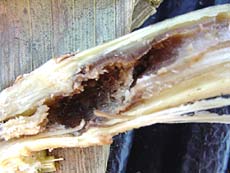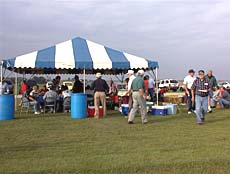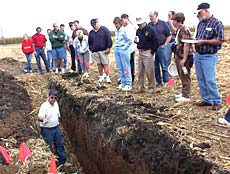|
Features,
Honors
& Awards, Ag
Announcements
Calendar,
Ag News Elsewhere
(fresh daily from the Web)
|
|
Features
|
|
Harvest progress
[SEPT.
23, 2002]
As of today, the harvest
progress stands at about 15 percent completed for corn harvest and
virtually 0 percent for soybeans. Corn progress varies widely by
local area as farmers have been searching for dry corn to start in.
Many area cornfields have been "opened up," meaning that end rows
have been harvested.
|
|
Moisture percentages have ranged from
the upper 20s down to the upper teens. Due to the cost of drying,
most producers don’t want to start harvest unless moisture is in the
lower 20s, unless there are problems with corn standing upright.
Once again there are pockets of corn that are lying flat on the
ground due to windstorms, corn borer damage and stalk rots.

[Photos provided by John Fulton]
Preliminary results from the county
corn borer survey indicate heavy corn borer pressure, especially on
the east side of the county. The average survey found almost four
borers per plant on the east side of the county in 24 of 25 plants.
These numbers will give us over a 10 percent yield loss due to
European corn borer this year. This is in addition to fields that
may be prone to stalk breakage in windstorms. Another factor is
possible dropping of ears due to corn borers weakening the shank
that attaches ears to the stalk.

[to top of second column in
this article]
|

Early yield reports have been as
expected — highly variable. Many yields reported have not been from
entire fields but from combine yield monitors and weigh wagons. The
low-end yields have been just over 100 bushels on some corn after
corn, and the high yields have been over 200 bushels per acre in
areas that received timely rainfall.
Where will yield averages fall?
Somewhere between those two numbers. As yields reports have not come
from whole field averages, take them with a grain of salt.
Individual field variation has been greater than the yield reports.
In another month or so, we’ll have a good handle on what yields
were.

[John
Fulton]
|
|
Heartland Community College
Your pathway to lifelong learning!
Community
Education Class through the Lincoln Center of HCC
For more
information or to register,
call 735-1731,
stop by HCC at 620 Broadway,
or go online at
hcc.cc.il.us/CCE |
Classes currently
available:
Herbaceous Perennials
7:00-9:00 pm,
9/24, U of I
Ext.
Intro to MS Excel
6:00-9:00 pm, 9/30 & 10/7, HCC
Vachel Lindsay
7:00-9:00 pm, 10/2, 9 & 16,
Oasis
Do's & Don'ts of
Landscaping
7:00-9:00 pm, 10/8,
U of I Ext. |
Lincolndailynews.com
is the place to
advertise
Call (217) 732-7443
or e-mail
ads@lincolndailynews.com |
|
|
|
Hartem observes National Farm Safety Week
[SEPT.
23, 2002] For National
Farm Safety Week the Hartsburg-Emden Intro to Ag class put up a
window display at the Hartsburg State Bank. [Photos provided
by ag class.]
|
|

 |

 |
|
 |
|
|
Other
countries are using it for energy production
What is
Miscanthus?
[SEPT.
21, 2002]
URBANA — In their search for
a crop that would yield greater biomass for fuel production,
European farmers chose Miscanthus. In fact, grassy biomass crops
such as Miscanthus are being used for energy production in Europe;
power stations fueled solely by plant biomass have been built and
are operational in Britain and Denmark; and most European countries
are using plant biomass to some extent and experiencing rapid
growth. Researchers at the University of Illinois in the College of
Agricultural, Consumer and Environmental Sciences are using computer
models to predict what Miscanthus yields would be when grown on
farms in the Midwest.
|
|
"This model, based on the European
experience with Miscanthus," said Steve Long, U of I plant
biologist, "predicts that no matter where the crop is grown in
Illinois, it will yield as good as or better than it does in Europe
— that is, yields of 11 to 17 dry tons per acre per year. Now, with
the support of C-FAR (Illinois Council on Food and Agricultural
Research) we are testing these model predictions with trials of the
crop across the state."
The potential for growing Miscanthus,
the benefits of grassland systems, management strategies and
applications for biofuel are some of the topics that will be covered
at the Sustainable Grassland Systems Field Day, from 8 a.m. to 3:30
p.m. Thursday, Oct. 17, at a field location just north of
Monticello.
Long said that crops such as Miscanthus
would add to the diversity of options for farmers, increasing
stability of farm incomes. "Once established, Miscanthus is a
low-input crop which adds large amounts of carbon to the soil, will
help to decrease errant nitrogen from entering our water supplies
and improve the quality of our soils."
Emily Heaton, who is conducting the
Illinois trials with Long and Tom Voigt at the university, added,
"Recent events in the United States and abroad have highlighted the
crucial need for energy sources that are not only clean and
renewable, but also domestically abundant. The federal government
has recognized the vital role agriculture can play in satisfying
U.S. energy demand. Biofuels, specifically energy crops, were
included in the new 2002 farm bill, reflecting the increasing
importance of these crops in the U.S. energy and agricultural
portfolios."
Long said that green energy from
perennial, grassy energy crops, particularly Miscanthus, provides an
opportunity for the agricultural and energy industries to work
together by growing profitable and sustainable new crops while
simultaneously providing clean, renewable fuel.
At the field day, morning speakers will
present information on topics relating to grazing, including the
economics of grazing, legislation and managing intensive grazing.
After a field tour, demonstration and lunch, there will be a
presentation by the Illinois Department of Agriculture’s AgriFIRST
program, followed by several experts speaking on topics related to
using plants as fuel, including Long’s presentation on Miscanthus
and a presentation from crop sciences graduate student Emily Heaton,
who works with Long. Attendees will have a chance to see firsthand
the largest field plot of Miscanthus for fuel production in the
United States.
[to top of second column in
this article]
|
The field location is just north of
Monticello and south of Lodge. Interstate 72, take Exit 166 at
Monticello’s Market Street. At the stop sign turn north. The Rick
Ridings auto dealership will be on your right. Continue on old Route
47 about 1.25 miles until you come to the end of Lodge Park. At this
point turn north onto Cry Baby Bridge Road, cross the Sangamon
River, and continue to the "Y." Turn west and continue for about
one-half mile until you come to the railroad tracks. Cross the
tracks, turn north and continue about one-half mile.
The Sustainable Grassland Field Day is
hosted by John Caveny, president of Environmentally Correct Concepts
in Monticello. "I believe that producing grassy bioenergy crops will
be a core enterprise on farms in Illinois in the near future,"
states Caveny. "Renewable base-load electric energy from grass is
one ag product that is not in surplus."
Other partners include Illinois
AgriFIRST, Dynegy Midwest Generation, Illinois Extension, NRCS and
the Dudley Smith Initiative. The field day is part of the 2002
Sustainable Agriculture Tours, sponsored by the Agroecology/Sustainable
Agriculture Program at the University of Illinois, the North Central
Region Sustainable Agriculture Research and Education Professional
Development Program, and the Illinois Small Farm Task Force.
"The tours and field days we’ve
sponsored this summer and fall have given people a chance to see a
variety of sustainable agriculture operations in action," said
Deborah Cavanaugh-Grant, Extension specialist for the University of
Illinois’ Agroecology/Sustainable Agriculture Program.
The entire Sustainable Grassland
Systems Field Day is free, including lunch. However please make a
reservation by Oct. 10. For more information and to register, please
contact John Caveny at (217) 762-7767 or by e-mail to
soilsteward@prairieinet.net.
The U of I Miscanthus project is funded
by C-FAR.
[U of I news release]
|
|
|
New
Zealand dairy trip open
[SEPT.
20, 2002]
URBANA — A University of
Illinois Department of Animal Sciences field study trip to New
Zealand focusing on that nation’s dairy industry has openings for a
number of non-students, said Gene McCoy, U of I dairy science
research specialist and organizer of the tour. The group will leave
Chicago on Jan 6 and return there on Jan. 18.
|
|
"This is a great opportunity to observe
the New Zealand dairy industry, its practices and research
first-hand," said McCoy, who will be leading the trip with Richard
Wallace, U of I Extension dairy veterinarian.
"We'll tour a number of dairy farms,
observe grazing practices and visit a research center. One of our
stops will be at a commercial deer ranch. Deer ranching is becoming
very popular in that country."
|
Transportation and lodging costs are
approximately $2,800 per person, not including spending money.
McCoy said
those interested should contact him by Sept. 23 at (217) 333-2625,
(217) 351-9106, or
g-mccoy@uiuc.edu.
[U of I news release] |
|
|
Aflatoxin problems in corn
isolated to southern Illinois
[SEPT.
19, 2002]
URBANA — Recent reports
indicate that elevators in southern Illinois have rejected some
truckloads of corn because of the presence of aflatoxin as indicated
by a black-light test. In some cases, levels have been reported as
high as 200 or 300 parts per billion. That compares to the cutoff
point of only 20 parts per billion for interstate commerce.
|
|
But according to Don White, professor
of fungal diseases of corn in the Department of Crop Sciences at the
University of Illinois, the pro blem appears limited only to a small
area in the southern part of the state.
"There certainly is no reason for the
markets to be panicked over this development," White said. "The
situation so far is restricted to a small geographical area. The
growers who need to watch out are those who are harvesting a
drought-stressed corn crop that is low in yield. I would be really
surprised if we have enough aflatoxin in the other areas of the
state to cause any real concerns."
White notes that it usually takes two
consecutive years of dry weather to produce widespread problems from
aflatoxin, which has not been the case in Illinois.
"The fungus that produces the toxin
normally does not do well when conditions are wet," he said. "It
just cannot compete well with other bacteria and fungi in such an
environment. Normally, however, you need two straight dry years
before the innoculum builds up to the high levels that can cause a
problem."
White points out that even those
growers who have their corn rejected at the elevator still have
several options open to them.
[to top of second column in
this article]
|
"High levels of aflatoxin are usually
found only in the broken and cracked kernels," White said. "Those
can often be screened out using a grain cleaner, leaving the
remaining corn below the threshold for aflatoxin contamination. The
loss in this process is usually only about 1 or 2 percent."
He adds that even corn with low to
moderate levels of aflatoxin can also be safely fed to finishing
steers.
"It is important, however, that corn
with aflatoxin should never be used to feed dairy cows, because it
metabolizes into an aflatoxin-like product in the milk," he said.
"Chickens also are very susceptible to problems from aflatoxin. But
certainly, finishing steers can handle it quite well."
White also warns against feeding any of
the corn screenings, which contain the cracked and broken kernels,
to any kind of animal. He further advises growers to be careful in
storing drought-stressed corn, because aflatoxin can be produced in
stored corn that has not been dried to at least 14.5 percent
moisture content.
"At this
point, there is no reason for major concern," he said. "We appear to
have a problem only in drought-stressed corn from a relatively small
area. We will continue to remain vigilant for any further problems
as harvest continues."
[U of I news release] |
|
|
First chamber-ag day a success
[SEPT. 17, 2002]
The first "Chamber Mixer on
the Farm" won’t be the last, according to Bobbi Abbott, director of
the Lincoln/Logan Chamber of Commerce. "It’s been such a success
that we hope to do it every year," she said.
|
|
About 75 people gathered Sunday
afternoon at the Jeff Elsas farm north of town to meet their
neighbors and learn how valuable farming is to the financial health
of Logan County. For example, commodities from the 729 farms in the
county bring in about $112 million in cash receipts each year.

[Photos by Joan Crabb]
Visitors also learned why Logan County
soils are so productive. Bill Dickerson, district conservationist
for Natural Resources Conservation Service, explained this as he
stood in an 8-foot-deep pit dug by a backhoe for the occasion.

The chance to see a slice of good Logan
County soil brought visitors to the edge of the pit. Dickerson
described the soil on Elsas’ farm as "the perfect balance for crop
production, as good a soil as you would find anywhere."
Sixteen inches of black topsoil sits on
top of a 4-foot layer of moderately well- to well-drained silty clay
loam that is "forgiving" enough to release water to plants and to
allow root systems to go deep, he explained. Below the clay loam is
a layer of sand.
The black organic matter came from
prairie grasses, which produced much more organic matter than
woodlands.
Called Tama silt loan, this soil was
deposited by wind after the last glacier, the Wisconsin, receded
about 15,000 years ago, according to scientists.

Mixer visitors also heard a
presentation by David Ramsey of the Land of Lincoln Agriculture
Coalition about the possibility of building a farmer-owned ethanol
plant in Elkhart.
[to top of second column in
this article]
|
Ramsey said if it becomes possible to
use the waste coal from the Turris mine, the proposed plant could be
one of the lowest-cost producers in the area. Turris is working on
ways to clean up high-sulfur Illinois coal so it can meet
Environmental Protection Agency standards.
Ramsey said the proposed plant would
use only the starch and sugar in corn to make the ethanol, so the
portion of the grain left would contain protein and be suitable for
animal feed.
Of every 10 gallons of gasoline
American drivers use, five gallons come from imported oil, four come
from domestic oil, which is environmentally costly to produce, and
one gallon comes from ethanol. That one gallon of ethanol would be
renewable every year, unlike the other nine gallons in the tank, he
said.
As other gasoline additives that reduce
vehicle emissions are being phased out, the demand for ethanol will
rise from the 2.4 billion gallons now in use to three billion
gallons, perhaps as high as 5.5 billion gallons within 10 years.
The proposed Elkhart plant would cost
$75 million and require about 1,000 farmer-landowner investors. It
would create 41 permanent jobs at the plant along with another 700
jobs for others, such as truckers hauling its products, he said.
The Land of Lincoln Agriculture
Coalition is a "think tank" of farmers and agribusiness people that
for the past two years has been trying to find ways to add value to
agriculture, according to Ramsey.
A highlight of the day for about 15 of
the visitors was a ride on Elsas’ eight-row John Deere combine as it
took a turn around the field. Some saw for the first time a combine
turning rows of standing corn into wagons full of golden kernels.
Elizabeth Murray Collins, almost 8
years old, was impressed with the demonstration.
"I’ve never been on anything that big
before," she said.
While demonstrating the combine, Elsas
also got most of a 30-acre stand of corn harvested, said his farming
partner Steve Haseley. Haseley said Elsas was getting about 180-185
bushels to the acre, with about 20 percent moisture content.
The harvested corn was trucked to the
East Lincoln elevator, which Hugh Whalen opened especially to
accommodate Elsas and the chamber mixer, Haseley said.
Bill Sahs of Lincoln was coordinator of
the event, and Larry Huelskoetter, chairman of the chamber’s ag
awareness subcommittee, served as master of ceremonies.
Farm equipment from Atlanta Ag Center
and Central Illinois Ag, also of Atlanta, was on the grounds for
visitors to see.
Marty Ahrends, co-chairman of the
chamber’s ag committee, said the chamber appreciated the cooperation
of Elsas and Haseley for the event.
"The ag committee and other producers
in Logan County are going to do a value-added agriculture visioning
process this winter to identify strengths and weaknesses and look
for opportunities to add value to the agricultural operation and to
the commodities they produce," she said.
Abbott said
she believes it is very important to make connections between
business people and ag producers. "I think we have made a good start
with this event," she said.
[Joan
Crabb]
|
|
|
Weekly outlook
September reports
[SEPT.
17, 2002]
URBANA — The relatively high
level of prices, the lack of carry in the corn and soybean price
structure, and the absence of loan deficiency payments all favor
harvest sales of corn and soybeans, said a University of Illinois
Extension marketing specialist.
|
|
"However, the tightness in the balance
sheets, the uncertainty about the South American growing season and
the need for large crops in the Northern Hemisphere next year
suggest that some ownership should be maintained into the winter and
spring months," said Darrel Good.
"Speculating on higher prices by
storing the crops is relatively expensive. Basis contracts or
ownership of futures may be less expensive, but not all producers
are willing to use these tools. The Commodity Credit Corporation
loan provides cash flow for those who choose to store part of the
crop."
Good’s comments came as he reviewed the
USDA’s September reports. The report of U.S. and world crop
prospects contained no major surprises. At 8.849 billion bushels,
the U.S. corn crop projection was 37 million bushels smaller than
the August projection, even though the U.S. average yield estimate
was increased by 0.2 bushels, to 125.4 bushels. Stocks of U.S. corn
at the end of the 2002-03 marketing year are expected to be a meager
729 million bushels, the lowest level in seven years.
Compared to the year just ended, the
USDA projects a 225-million-bushel reduction in feed and residual
use of corn during the current marketing year, a 115-million-bushel
increase in domestic processing use of corn, and a
100-million-bushel increase in U.S. exports.
"Few doubt that processing use of corn
will increase, due to expanded ethanol capacity," said Good.
"Opinions differ on prospective feeding and exports of U.S. corn.
The projected decline in feed use will have to come as the result of
fewer animals or a decline in the amount of grain fed per animal
since the decline in corn consumption is not expected to be offset
by increased feeding of other grains.
"The USDA’s Dec. 1 Grain Stocks report,
to be released in early January, will reveal the rate of domestic
feed and residual use of corn during the first quarter of the
2002-03 marketing year. That report will be important in determining
if corn prices are generating the necessary adjustments in use."
Good added that the projected increase
in U.S. corn exports reflects expectations of a small increase in
world consumption and a decline in exports from Argentina. Chinese
exports are expected to increase by 59 million bushels (19 percent)
due to a 433-million-bushel (10 percent) increase in production. As
of Sept. 5, 244 million bushels of U.S. corn had been sold for
export during the current marketing year, 17 million less than sales
of a year ago.
"The market will continue to monitor
weekly sales and export reports, as well as the sales of Chinese
corn, for clues as to the accuracy of the USDA projection," said
Good.
[to top of second column in
this article]
|
At 2.656 billion bushels, the USDA’s
September projection of the U.S. soybean crop was 28 million bushels
larger than the August projection. A small reduction in the
projection of harvested acreage was more than offset by an increase
in the expected yield. The U.S. average yield is now projected at 37
bushels per acre, 0.5 bushels above the August projection but 2.6
bushels below the 2001 average yield.
For the current U.S. marketing year,
the USDA projects a 215-million-bushel (20 percent) decline in
exports and a 25-million-bushel (1.5 percent) decline in the
domestic crush.
"The decline in consumption is being
required by the smaller crop," said Good. "Year-ending stocks are
expected to total only 160 million bushels, the lowest level in six
years. Part of the reduction will be accomplished through higher
prices, but much of the cut in U.S. exports is expected to be offset
by larger South American exports.
"For the year October 2002 through
September 2003, the USDA expects South American exports to total
1.25 billion bushels, 367 million bushels more than exported in the
previous 12 months. The larger projection reflects the large 2002
South American crop, an expected 8.7 percent increase in production
in 2003 and continued expansion in world soybean consumption."
As of Sept. 5, export sales of U.S.
soybeans totaled 213 million bushels, 4.5 million larger than sales
of a year ago. The market will continue to pay close attention to
the rate of U.S. soybean export sales and the development of the
South American crop.
Corn and soybean prices moved higher
prior to the release of the USDA’s report on Sept. 12. The lack of
surprises in the report and the start of the Midwest harvest allowed
December corn futures to decline about 20 cents and November soybean
futures to decline about 30 cents following the release of the
reports.
"In addition to the ongoing reports on
the rate of consumption, the market will react to yield reports over
the next several weeks," said Good. "Given the expected drawdown in
U.S. and world inventories, small changes in expected crop size
could have important price implications.
"Those small
inventories also mean that prices could be very sensitive to 2003-04
production prospects."
[U
of I news release]
|
|
|
Honors
& Awards
|
|
|
Ag
Announcements
|
|